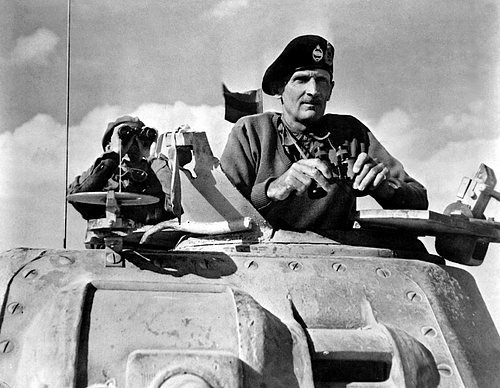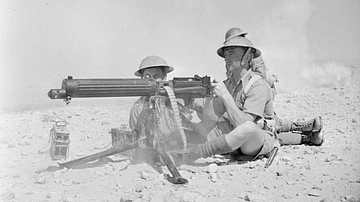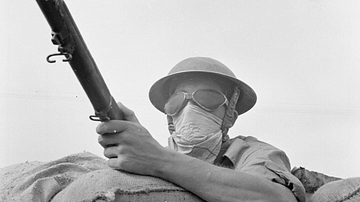
Field Marshal Bernard Montgomery (1887-1976) was one of Britain's top commnaders in the Second World War (1939-45). He famously defeated Erwin Rommel (1891-1944) at the Second Battle of El Alamein in North Africa in November 1942. Known for his cautious thoroughness and eccentric uniform, the national hero was also involved in the invasion of Italy, the Normandy landings, and the race to the Rhine.
Early Life
Bernard Law Montgomery was born on 17 November 1887 in Kennington, London. Bernard's father, Henry, was an Irish Protestant clergyman, and his grandfather had been a dean of Canterbury. Bernard's mother, Maud, was the daughter of the writer Dean Farrar. With eight siblings, Bernard had plenty of time to escape parental supervision and get up to mischief. He recalled his mother often repeatedly saying "Go and find out what Bernard is doing and tell him to stop it" (Memoirs, 17). As Bernard's father was appointed bishop of Tasmania, the family moved there in 1889, Bernard only returning to England in 1901. Graduating from the Sandhurst military academy in 1908, Bernard joined the Royal Warwickshire Regiment where he served in India, which included several years on the volatile North West Frontier. He served his country in Europe in the First World War (1914-18), receiving the Distinguished Service Order at the First Battle of Ypres but suffering an injury that had him sent home to a hospital in England. Montgomery reached the rank of brigade major and during the rest of the contfict, he served the Chiefs of Staff, far from the madness of the trenches.
Interwar Years
After WWI, Montgomery studied at Camberley, the British Army staff college, where he worked as an instructor from 1926. Montgomery was himself a keen student of military history. He was asked to rewrite the official Infantry Training Manual. In 1927, he married, rather late at the age of 39, Betty Carver. Betty was a war widow. In 1928, the couple's only child, David, was born. The marriage lasted a decade and was then tragically curtailed when Betty died from an infected insect bite. Thereafter, Montgomery dedicated himself entirely to military life as he steadily worked up to higher ranks of the service. In 1938, as war loomed in Europe, Major-General Montgomery served in Palestine where he helped put down an Arab uprising. Returning to England, Montgomery was appointed the commander of the 3rd Division at the end of August 1939. A few days later, WWII began.
Montgomery commanded the 2nd Corps, part of the British Expeditionary Force (BEF) intended to bolster the defence of Belgium and France against Nazi Germany's attack. Although the BEF was obliged to retreat and escape with what it could at the Dunkirk Evacuation of May-June 1940, Montgomery at least rose up another rung to lieutenant-general. Back in England and head of the 3rd Division, Montgomery had his first encounter with the British prime minister, Winston Churchill (1874-1965), who was not particularly impressed with the eccentric commander. Montgomery boasted to Churchill that he neither drank nor smoked and was 100% fit, to which Churchill replied that he both drank and smoked but was 200% fit (Churchill lived to 90, a feat Montgomery did not manage). Not much happened to the general for the next two years as he took on various home commands. Montgomery's big chance would come, of all places, in the desert of North Africa.
Character & Eccentricities
The historian J. Holland gives the following summary of Montgomery's physical characteristics:
At five foot seven, he was unimposing physically, had thinning hair, a beaky expression, and a rather shrill voice that was incapable of pronouncing its 'Rs' properly…But however unprepossessing Monty's appearance may have been, he did have piercing eyes, as keen as hawk's – eyes that bore into whoever he was talking to without ever appearing to blink.
(254)
Montgomery was a stickler for routine, often retiring to bed early at 9 p.m. each night, no matter what earth-shattering offensive was about to get underway the next morning. In his short evenings, he relaxed by reading in his command caravan, where he kept a pet canary. The sometimes prickly militarist was not without a sense of humour; he once owned two dogs, a King Charles spaniel and a Jack Russel, which he named Rommel and Hitler.
As a general, critics then and now consider Montgomery rather ponderous, too meticulous in his planning, and too cautious when advancing. His brusque manner and arrogance were frequently noted by fellow officers, particularly those in the United States army. Churchill once described Montgomery as "indomitable in retreat, invincible in advance, insufferable in victory" (Boatner III, 373). Montgomery, or 'Monty', as he was affectionately known, was indisputably popular with ordinary soldiers, principally because he communicated to them well with familiar language (one of his favourite expressions was the cricketing metaphor "we'll hit them for six"), and he beamed confidence, both in himself and their abilities to defeat the enemy. Under Montgomery's leadership, the ordinary troops felt involved in the coming battles, as here explained by Lieutenant Colonel Belchem:
He [Montgomery] introduced an entirely new philosophy, namely that before going into a major new offensive operation everybody, including if you like the nursing orderlies in the hospital, should know broadly what was the commander's intention in the coming battle, so that everybody could feel he had a part to play in achieving that objective.
(Holmes, 274)
Another method Montgomery consciously used to better communicate to his men besides speeches and personally visiting as many of them as possible, was his uniform. He frequently went casual and wore slacks and a wool sweater devoid of all rank badges. In cooler weather, he wore a loose gabardine coat. The general's odd assemblage led one US staff officer to remark that he looked "like a poorly tailored Bohemian painter" (Caddick-Adams, 335).
Montgomery most often wore a black beret, as personnel of the Royal Tank Regiment (RTR) did, but he sometimes wore a New Zealand hat instead when he went to address troops from that country and an Australian slouch hat (festooned with the badges of each unit he chatted to) when he addressed Australians. The beret remained the most consistently worn item, chosen to make the general instantly recognisable and distinct from any other commander. Montgomery wore at the front of his beret not one but two badges: the insignia of a general and the badge of the RTR. The press was certainly enamoured with Monty's choice of wardrobe, the general appearing in his distinctive beret on the war-time covers of magazines like Life and Time. The Allies had at last found themselves a a cult hero to rival Rommel.
North Africa & El Alamein
North Africa was important because control of it also meant control of vital Mediterranean shipping lanes and the Suez Canal. Churchill was also keen to take the fight to the enemy, and the only place to do this, as the British Empire stood alone, was outside Europe. The Western Desert Campaigns (June 1940 to January 1943) had been a pendulum affair with Allied and Axis forces exchanging victories and losses in more or less equal measure. The tide began to turn in the Allies' favour as their superior supplies gave them an advantage in both men and material. The crunch came at El Alamein, a tiny desert railway halt located 60 miles (95 km) west of Alexandria. This was 'Monty's' moment in history.
The Allies decided to hold a defensive line running from El Alamein in the north to the Qattara Depression in the south. The line was 40 miles (65 km) long, but the soft sands and salt marshes of the Qattarra, which could not be crossed by heavy vehicles, meant that the Axis commander Erwin Rommel could not, as he had so often done before, outflank the Allied troops. Rommel attacked the positions at El Alamein on 1 July. This First Battle of El Alamein ended on 27 July in something of a draw. The British and Empire troops, aided by the Allied Western Desert Air Force, had resisted but Rommel's army was still intact and very much a threat. However, Rommel was suffering severe supply problems as the Nazi leader Adolf Hitler (1889-1945) focussed on the Eastern Front, and those supplies that were sent to North Africa were often sunk in Allied air and naval attacks.
Montgomery took command of the British Eight Army in North Africa in August 1942. The job was actually given to General William Gott, but he died when his plane was shot down, and so Montgomery finally got his chance for glory. This was a good time to take over, which Montgomery himself noted in his memoirs: "I had taken command of truly magnificent material" (Memoirs, 107). Reinforcements and new weaponry bolstered the Allied armies. Superior US tanks like the Sherman, better artillery pieces, and greatly improved air support all aided Montgomery's plans. Another help was the fact that the enemy was stretching their supply lines to their very limit.
Montgomery, a stickler for physical exercise, training, rehearsals, and discipline, replaced any doubters or dissenters amongst his officer staff, the reason, he felt, for the low morale of the 8th Army before he took over. Montgomery gave his orders personally whenever possible, usually each morning and evening. Oozing implacable calm, he revitalised his troops, preparing them to push out from their defences at El Alamein. Montgomery frequently toured his army in an old Humber car or a tank with his name blazoned on the side and his general's flag fluttering from the aerial, dishing out cigarettes to anyone who wanted them, which was everyone.

The Eighth Army, reorganised into multiarmed divisions, won the Battle of Alam Halfa (30 August to 7 September 1942), largely thanks to excellent coordination between air and ground forces and Rommel's limitations in fuel and ammunition. Montgomery was determined for a more comprehensive victory, though, and so he planned for another offensive, one which would become known as the Second Battle of El Alamein.
Allied intelligence revealed Rommel's imminent plans to attack the El Alamein line, and so Montgomery moved first. The Axis defences included extensive minefields known as the 'Devil's gardens', and these would severely hamper the Allied advance and follow-up moves after the battle. The Allied army was composed of British and British Empire troops, as well as Free French and Greek troops. Montgomery began this set-piece battle with a massive artillery barrage on 23 October. Infantry divisions then moved in, clearing paths through the mines to allow the armoured divisions to roll in behind. Air strikes were made in constant support to ground troops. There were heavy casualties as Montgomery used his superior numbers to wear down the enemy, rotating his men and sending in fresh divisions. By the first days of November, Rommel was in full retreat. The battle was won, 30,000 Axis prisoners were taken, and the port of Tobruk was back in Allied hands.
Montgomery was later criticised for not crushing completely the enemy here, but the post-battle chase was hampered by the minefields, poor weather, and Montgomery's determination that this would not be another temporary push westwards but a final and overwhelming closing down on the Axis armies. Montgomery was promoted to full general and given a knighthood as the British made much of their new hero and this most vital victory.
Meanwhile, Rommel withdrew to Tunisia to fight another day, but his ambitions in Africa were already over. In Operation Torch of November 1942, just a few days after El Alamein, three new Allied armies landed in North Africa in November 1942 and headed eastwards. Montgomery, meanwhile, pressed on westwards and captured Tripoli in January 1943. Rommel enjoyed a last hurrah at the Battle of Kasserine Pass in February 1943. Montgomery's Eighth Army (and he always called it "his") then won the Battle of Medenine (6 March 1943). Victory in North Africa came when the Axis armies surrendered in May 1943. Now a new front of the war opened up: Italy.

The Italian Campaign
Montgomery continued to command the 8th Army during the invasion of Sicily, which began on 10 July 1943, a campaign to which Montgomery also made a significant contribution in terms of planning. Montgomery methodically took the eastern side of the island, but he was outpaced by the US general, George Patton (1885-1945), commanding the US 7th Army, although, in truth, Montgomery faced the stiffer enemy resistance. The Axis army was able to withdraw from Sicily to fight again another day, and then further delays moving up through mainland Italy meant Montgomery was unable to assist, as planned, the US attack on Salerno. As a consequence, "the British military hero became increasingly disliked by American generals" (Boatner III, 374).
Normandy
In the D-Day Normandy landings of June 1944, Montgomery was in charge of all ground forces, 39 divisions. Once again, he made important suggestions during the planning stage, displaying "his best qualities. His energy and organizational skills, his ability to grasp the essentials of a problem, and his insistence on simplicity, all contributed to its success" (Dear, 592). General Omar Bradley (1893-1981) considered Montgomery's contribution to the planning stage as "invaluable…nothing was left to chance or improvisation in command" (Caddick-Adams, 328). Montgomery also repeated his tours that had buoyed his men in Africa: "I was determined to address all officers down to the lieutenant-colonel level...I visited every corps and divisional area, and spoke to audiences of from 500 to 600 officers at a time…It took eight days in all and was an exhausting tour" (Memoirs, 239).
On 1 September 1944, after D-Day's success, Montgomery was promoted to field marshal. What to do after the initial landings became problematic. Montgomery was misguided in trying to take Caen before all else and then disagreed with the Allied supreme commander, Dwight D. Eisenhower (1890-1969), on how to proceed with the campaign. Eisenhower wanted a broad front maintained while Montgomery favoured a narrow push to the Low Countries. Eisenhower's view prevailed.

Operation Market-Garden
Montgomery dreamed of a quick end to the war and gained approval for a massive airdrop of parachute troops behind the German lines. This was Operation Market-Garden. The objective was to outflank the enemy, take the bridges across the Rhine River around Arnhem, and cut off the German retreat. The operation, conducted between 17 and 25 September 1944, was a failure and resulted in high casualties. Montgomery acknowledged that the operation could have been planned better, but he insisted that poor weather, the unexpected presence of two panzer divisions, the early capture by the enemy of the operation plans, and a lack of support from his superiors were the main reasons for the failure. Certainly, the escapade damaged Montgomery's reputation.
The general regained his sparkle with his role in the German fightback at the Battle of the Bulge in December but then rather overdid his self-praise again, further upsetting his US colleagues by suggesting in a press conference that he alone had saved their bacon. Montgomery was, in the end, obliged to write an apology to Eisenhower to restore British-US relations. Eisenhower had noted after first meeting Montgomery in Africa back in 1943 that he "is unquestionably able, but very conceited" (Holland, 651). Montgomery at least finished the war on a high, liberating the Netherlands and Denmark, overseeing the German surrender in the northwest, and, from May 1945, commanding the British Army of Occupation.
Post-War Career
In January 1946, Montgomery received a life peerage; his chosen title was Viscount Montgomery of Alamein. Later that year, he was made a Knight of the Order of the Garter to add to an already bulging chest of medals. Montgomery served as chief of the Imperial General Staff from 1946 to 1948 and then held various senior military positions as the Cold War reshaped the West's armed forces ready to face a new threat. Montgomery retired in September 1958 to live in Isington Mill in Alton, Hampshire. He shared his home with his son and, becoming something of a recluse, dedicated himself to writing a far from impartial book of memoirs, which include much interesting material such as reproduced correspondence between key actors in WWII. Although a bestseller, the book's one-sided views only lost Montgomery further friendships.
In later life, Montgomery was haunted, as he had been at the time, by the deaths in war he had been responsible for. As he wrote down in his final days of ill health, "I've got to go and meet God – and explain all those men I killed at Alamein" (Caddick-Adams, 468). The field marshal, for all his public cockiness, in private remained highly concerned for those who had served under him during the war. One soldier's mother, speaking 15 years after the war ended, confided that Montgomery was "a wonderful man. My son was one of his soldiers. When he was killed I wrote to the General about him and he wrote back. Now he sends me a letter every Christmas. My boy would have been so proud to know this" (Caddick-Adams, 464).
Bernard Montgomery died on 25 March 1976. The field marshal, still a British national hero, as the tens of thousands of respectful bystanders bore evidence, received a state funeral in Saint George's Chapel in Windsor Castle. His grave lies in the small country churchyard of Binstead not far from his final home.









